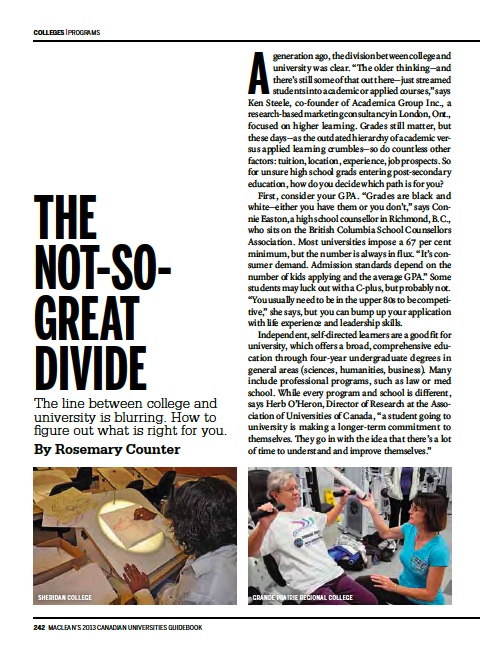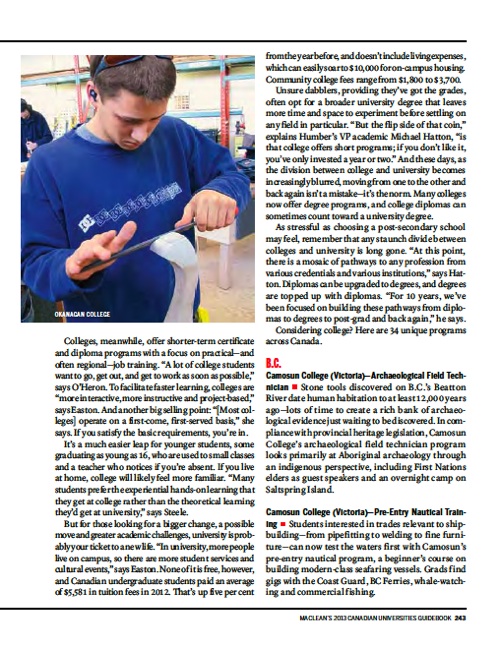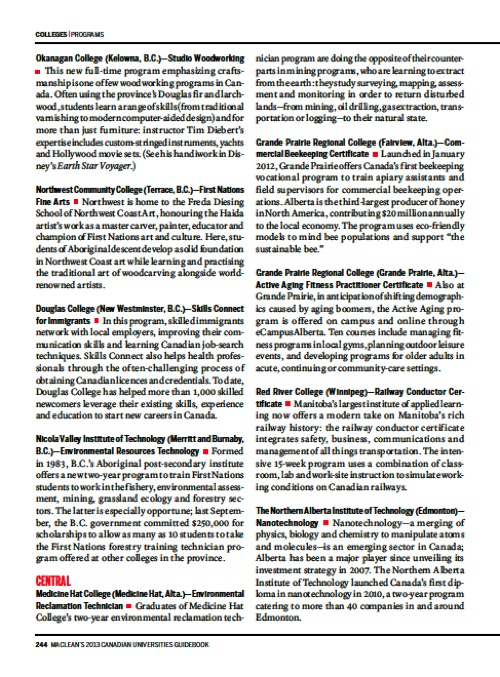The (Not-So) Great Divide
The line between colleges and universities is blurring. How to figure out which is right for you.
A generation ago, the division between college and university was clear. “The older thinking—and there’s still some of that out there—just streamed students into academic or applied courses,” says Ken Steele, co-founder of Academica Group Inc., a research-based marketing consultancy in London, Ont., focused on higher learning. Grades still matter, but these days—as the outdated hierarchy of academic versus applied learning crumbles—so do countless other factors: tuition, location, experience, job prospects. So for unsure high school grads entering post-secondary education, how do you decide which path is for you?
First, consider your GPA. “Grades are black and white—either you have them or you don’t,” says Connie Easton, a high school counsellor in Richmond, B.C., who sits on the British Columbia School Counsellors Association. Most universities impose a 67 per cent minimum, but the number is always in flux. “It’s consumer demand. Admission standards depend on the number of kids applying and the average GPA.” Some students may luck out with a C-plus, but probably not. “You usually need to be in the upper 80s to be competitive,” she says, but you can bump up your application with life experience and leadership skills.
Independent, self-directed learners are a good fit for university, which offers a broad, comprehensive education through four-year undergraduate degrees in general areas (sciences, humanities, business). Many include professional programs, such as law or med school. While every program and school is different, says Herb O’Heron, Director of Research at the Association of Universities of Canada, “a student going to university is making a longer-term commitment to themselves. They go in with the idea that there’s a lot of time to understand and improve themselves.”
Colleges, meanwhile, offer shorter-term certificate and diploma programs with a focus on practical—and often regional—job training. “A lot of college students want to go, get out, and get to work as soon as possible,” says O’Heron. To facilitate faster learning, colleges are “more interactive, more instructive and project-based,” says Easton. And another big selling point: “[Most colleges] operate on a first-come, first-served basis,” she says. If you satisfy the basic requirements, you’re in.
It’s a much easier leap for younger students, some graduating as young as 16, who are used to small classes and a teacher who notices if you’re absent. If you live at home, college will likely feel more familiar. “Many students prefer the experiential hands-on learning that they get at college rather than the theoretical learning they’d get at university,” says Steele.
But for those looking for a bigger change, a possible move and greater academic challenges, university is probably your ticket to a new life. “In university, more people live on campus, so there are more student services and cultural events,” says Easton. None of it is free, however, and Canadian undergraduate students paid an average of $5,581 in tuition fees in 2012. That’s up five per cent from the year before, and doesn’t include living expenses, which can easily soar to $10,000 for on-campus housing. Community college fees range from $1,800 to $3,700.
Unsure dabblers, providing they’ve got the grades, often opt for a broader university degree that leaves more time and space to experiment before settling on any field in particular. “But the flip side of that coin,” explains Humber’s VP academic Michael Hatton, “is that college offers short programs; if you don’t like it, you’ve only invested a year or two.” And these days, as the division between college and university becomes increasingly blurred, moving from one to the other and back again isn’t a mistake—it’s the norm. Many colleges now offer degree programs, and college diplomas can sometimes count toward a university degree.
As stressful as choosing a post-secondary school may feel, remember that any staunch divide between colleges and university is long gone. “At this point, there is a mosaic of pathways to any profession from various credentials and various institutions,” says Hatton. Diplomas can be upgraded to degrees, and degrees are topped up with diplomas. “For 10 years, we’ve been focused on building these pathways from diplomas to degrees to post-grad and back again,” he says.
Considering college? Here are 34 unique programs across Canada.
Camosun College (Victoria)—Archaeological Field Technician
Stone tools discovered on B.C.’s Beatton River date human habitation to at least 12,000 years ago—lots of time to create a rich bank of archaeological evidence just waiting to be discovered. In compliance with provincial heritage legislation, Camosun College’s archaeological field technician program looks primarily at Aboriginal archaeology through an indigenous perspective, including First Nations elders as guest speakers and an overnight camp on Saltspring Island.
Camosun College (Victoria)—Pre-Entry Nautical Training
Students interested in trades relevant to shipbuilding—from pipefitting to welding to fine furniture—can now test the waters first with Camosun’s pre-entry nautical program, a beginner’s course on building modern-class seafaring vessels. Grads find gigs with the Coast Guard, BC Ferries, whale-watching and commercial fishing.
Okanagan College (Kelowna, B.C.)—Studio Woodworking
This new full-time program emphasizing craftsmanship is one of few woodworking programs in Canada. Often using the province’s Douglas fir and larchwood, students learn a range of skills (from traditional varnishing to modern computer-aided design) and for more than just furniture: instructor Tim Diebert’s expertise includes custom-stringed instruments, yachts and Hollywood movie sets. (See his handiwork in Disney’s Earth Star Voyager.)
Northwest Community College (Terrace, B.C.)—First Nations Fine Arts
Northwest is home to the Freda Diesing School of Northwest Coast Art, honouring the Haida artist’s work as a master carver, painter, educator and champion of First Nations art and culture. Here, students of Aboriginal descent develop a solid foundation in Northwest Coast art while learning and practicing the traditional art of woodcarving alongside world-renowned artists.
Douglas College (New Westminster, B.C.)—Skills Connect for Immigrants
In this program, skilled immigrants network with local employers, improving their communication skills and learning Canadian job-search techniques. Skills Connect also helps health professionals through the often-challenging process of obtaining Canadian licences and credentials. To date, Douglas College has helped more than 1,000 skilled newcomers leverage their existing skills, experience and education to start new careers in Canada.
Nicola Valley Institute of Technology (Merritt and Burnaby, B.C.)—Environmental Resources Technology
Formed in 1983, B.C.’s Aboriginal post-secondary institute offers a new two-year program to train First Nations students to work in the fishery, environmental assessment, mining, grassland ecology and forestry sectors. The latter is especially opportune; last September, the B.C. government committed $250,000 for scholarships to allow as many as 10 students to take the First Nations forestry training technician program offered at other colleges in the province.
Medicine Hat College (Medicine Hat, Alta.)—Environmental Reclamation Technician
Graduates of Medicine Hat College’s two-year environmental reclamation technician program are doing the opposite of their counterparts in mining programs, who are learning to extract from the earth: they study surveying, mapping, assessment and monitoring in order to return disturbed lands—from mining, oil drilling, gas extraction, transportation or logging—to their natural state.
Grande Prairie Regional College (Fairview, Alta.)—Commercial Beekeeping Certificate
Launched in January 2012, Grande Prairie offers Canada’s first beekeeping vocational program to train apiary assistants and field supervisors for commercial beekeeping operations. Alberta is the third-largest producer of honey in North America, contributing $20 million annually to the local economy. The program uses eco-friendly models to mind bee populations and support “the sustainable bee.”
Grande Prairie Regional College (Grande Prairie, Alta.)— Active Aging Fitness Practitioner Certificate
Also at Grande Prairie, in anticipation of shifting demographics caused by aging boomers, the Active Aging program is offered on campus and online through eCampusAlberta. Ten courses include managing fitness programs in local gyms, planning outdoor leisure events, and developing programs for older adults in acute, continuing or community-care settings.
Red River College (Winnipeg)—Railway Conductor Certificate
Manitoba’s largest institute of applied learning now offers a modern take on Manitoba’s rich railway history: the railway conductor certificate integrates safety, business, communications and management of all things transportation. The intensive 15-week program uses a combination of classroom, lab and work-site instruction to simulate working conditions on Canadian railways.
The Northern Alberta Institute of Technology (Edmonton)—Nanotechnology
Nanotechnology—a merging of physics, biology and chemistry to manipulate atoms and molecules—is an emerging sector in Canada; Alberta has been a major player since unveiling its investment strategy in 2007. The Northern Alberta Institute of Technology launched Canada’s first diploma in nanotechnology in 2010, a two-year program catering to more than 40 companies in and around Edmonton.
Great Plains College (multiple campuses, Saskatchewan)—Industry and Safety Training
Great Plains College’s slogan, “Education with Energy,” is applied literally at its Energy Training Centre, where post-secondary industry and safety training prepares students for careers in Saskatchewan’s oil and gas industries. It’s also home to the province’s only fall-hazard indoor training facility, the Fall Protection Tower, which opened as part of the newly renovated Swift Current Campus.
Northern Star College (Edmonton)—Hypnotherapy Certificate
Hypnotherapy isn’t for just hippies and mystics—it’s increasingly used in Canada for weight loss, smoking cessation, migraine treatment and as a therapy aid. Believers can start with a one-year certificate in hypnotherapy, which includes classes on essences and energy, systemic constellation, and self-hypnosis.
Lethbridge College (Lethbridge, Alta.)—Power Line Technician
Program Electricity experts say most of Canada’s infrastructure needs to be expanded or replaced—especially in Alberta, the country’s largest producer of energy, where 4,000 new skilled technicians will be required in the next five years. Since this January, Lethbridge’s progressive, up-to-date program (in partnership with the City of Lethbridge, Alta., Link and Rockstad Power Corp.) provides hands-on and theoretical training for the burgeoning field.
Steinbach Bible College (Steinbach, Man.)—Certificate of Ministry Studies
Ministers of tomorrow can study from a distance with Steinbach Bible College’s new online learning program. More than 30 fully transferable online courses—in the areas of Bible/theology, arts and sciences, and ministry—can count toward a certificate, diploma or even a Bachelor of Arts.
Humber College (Toronto)—Bachelor of Journalism
Journalism-bound students looking for a career in Toronto’s media scene can skip the traditional university route with Humber’s renowned four-year bachelor’s degree program. A broad first year is followed by a second-year specialization in one of four media facets: Humber runs a full television studio and radio station, as well as newspapers and magazines.
Seneca College (King City, Ont.)—Gerontology
Now that baby boomers have hit retirement age, shifting demographics will mean good business for gerontologists. Plenty of alternative retirement communities in the Greater Toronto Area will be hiring graduates of Seneca College’s gerontology program—transferable toward a degree in social work—who have learned skills in interventions, family communication, bereavement and grief.
St. Lawrence College (Kingston, Ont.)—Culinary
A revival in eastern Ontario’s artisanal cheese industry is creating new demand for culinary students who, through collaborations with students in biotechnology and business, are becoming lab researchers assisting local cheese makers. With the support of Ontario’s Ministry of Agriculture, St. Lawrence is researching not just taste and texture, but market needs and opportunities, as well as innovations in business processes.
Niagara College (Niagara-on-the-Lake, Ont.)—Winery, Viticulture and Brewery Studies
Niagara College’s Canadian Food and Wine Institute offers a combined approach to wine, culinary and beer education. Home to Canada’s only commercial teaching winery and fully licensed teaching brewery, it offers a variety of options for budding winemakers and brewmasters: winery, viticulture and brewery studies students choose from certificate, diploma or graduate programs.
Sheridan College (Oakville, Ont.)—Animation
Twenty-five years before Toy Story wowed moviegoers, Sheridan College offered animation, earning a reputation as “the Harvard of animation colleges.” Grads head straight to work with the digital giants—Pixar, Dreamworks and Cookie Jar—keeping Canada fiercely competitive in
alternative media and the 3D digital boom.
LaSalle College (Montreal)—Technical Clothing Designer
For fashionistas looking to showcase their creations in Montreal’s fashion scene, the International School of Fashion, Arts and Design at LaSalle College offers a one-year program in technical clothing—that is, high-performance snowboard, ski and scuba apparel. Students are trained from conceptualization to design of this high-value niche product that caters to Quebec’s sports scene.
Durham College (Oshawa, Ont.)—Web Applications for Mobile Commuting
Good or bad, a 2012 Rogers Communications survey found 65 per cent of us feel “naked” without our smartphones. But it’s very good news for savvy web developers, who might try this new graduate certificate (beginning in September 2013), where experienced working computer buffs can amp up their Apple and Android programming skills for use on new websites, apps, and whatever cutting-edge social media are next.
Fleming College (Cobourg, Ont.)—Solar Photovoltaic System
Planning & Installation Certificate Sarnia, Ont., was briefly home to the world’s largest photovoltaic solar farm—China and India have since copied our model—which generated power for more than 12,000 homes. Prospects in this growth industry are exponential, hence Fleming’s new solar program, including classes such as 3D computer modelling and drafting, renewable energies, and solar installation job site safety, all designed to meet criteria for the North American Board of Certified Energy Practitioners.
St. John’s Marine Institute (St. John’s, Nfld.)—Ocean Mapping
St. John’s Marine Institute offers a joint diploma/degree in ocean mapping, teaching the solid technical skills needed to collect, manage and analyze ocean data from the surface to the seabed. There’s no shortage of material for treasure hunters, either; Library and Archives Canada estimates more than 25,000 shipwrecks exist off of Canada’s East Coast.
Holland College (Summerside, P.E.I.)—Wind Turbine Technician
The global market for wind energy—sustainable and fuel-free, with no greenhouse gas emissions—is expanding faster than any other source of electric energy, and P.E.I. is emerging as one of the most progressive renewable energy leaders in North America. Holland College is preparing workers with its wind turbine technician program at its Summerside location, ripe with strong gusts to keep the windmills spinning.
College of the North Atlantic (multiple campuses, Newfoundland)—Emergency Management Education
Beyond the coast’s obvious natural disasters—hurricanes, snowstorms and flooding caused by the unruly Atlantic—government agencies have been expanding their emergency and contingency plans since 9/11. Graduates of the emergency management education program, with the help of cutting-edge 3D technology at the Manufacturing Technology Centre, will be prepared for any number of worst-case scenarios.
Nova Scotia Community College (multiple campuses, N.S.)—Fishing Master Certification
The second-smallest Canadian province exports a whopping $1 billion in fish to 90 countries around the world. To keep up with demand, Nova Scotia Community College’s School of Fisheries offers a fishing master certification, teaching everything from boating safety to fish-harvesting technology.
Nova Scotia Community College (Cumberland, N.S.)—Refrigeration and Air Conditioning: Geothermal
Nova Scotia Community College offers access to some of the world’s deepest abandoned coal mines—mines that have flooded over time—as the ideal setting to study refrigeration and air conditioning: geothermal. Two geothermal wells have been drilled below the campus, providing a “living” training lab for students to monitor and maintain geothermal energy—a cutting-edge trade aligning with Nova Scotia’s growing renewable energy sector.
Yukon School of Visual Arts (Dawson City, Yukon)—Visual Arts
A renewed art initiative merges the Yukon School of Visual Arts with the Tr’ondëk Hwëch’in, or People of the River, who have resided along the Yukon River for millennia. The progressive and holistic visual arts program, with a mandate to support First Nations arts and practices, is widely accepted across the whole country; it’s accredited at Emily Carr, OCAD, ACAD and more.
Aurora College (Yellowknife)—Introduction to Underground Mining
Settled in the ’30s after the discovery of gold, Yellowknife eventually shifted from a mining town to a government centre—until the mid-’90s diamond boom prompted the Northwest Territories to return to its roots. De Beers’ fourth mine, the Gahcho Kue, is currently in production, and the region will be ready: Aurora College’s community-based introduction to underground mining includes a “Ready to work North” course, which students fast-track through in just six weeks.
Nunavut Arctic College (multiple campuses, Nunavut)—Fur Production and Design
Head due north to Nunavut, where fur isn’t murder, it’s art. Fur production and design at Nunavut Arctic College teaches traditional Inuit methods to prepare sealskin, sew garments and sell them in a contemporary market. And students are at the top of their game: Former student Rosie Audlakiak’s form-fitting sealskin vest won first place at the 2010 national Fur Re-Invented competition in Montreal.
Yukon College (Whitehorse)—First Nations Governance and Public Administration
Given degree-granting status in 2009, Yukon a lready leads Canada with 14 First Nations self-governments—11 of which have settled their land claims. Tomorrow’s Aboriginal leaders train at Yukon College, where the First Nations governance and public administration program offers classes in economic development, power and influence and, of course, land claims.
Yukon College (Whitehorse)—Mineral Resources
Nature lovers flock to remote field camps to learn mineral exploration and mining in the vast Canadian wilderness. Students explore the terrain of the territory and the world of mining through a mixture of office and fieldwork before entering the workforce, where mineral resource grads are well paid and highly sought after.
Aurora College (Yellowknife)—Northern Leadership Development Program
With the sponsorship of their employers, talented Northerners demonstrating leadership skills at work can upgrade to management, supervisory or leadership positions—whatever their industry or business—via Aurora College, operating at three campuses and 23 community centres. Now in its second year, the northern leadership development program fosters a unique mentor-employee relationship that primes the worker for fast promotion into leadership roles. Courses include personal development, effective team leadership and conflict resolution.


